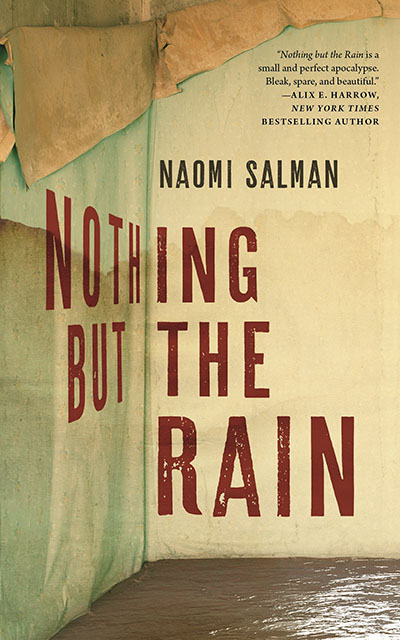

4/19/2023
Naomi Salman's Nothing but the Rain is a tense, haunting disaster novella set in a time of extreme climate change. It takes place in a town called Aloisville, where it's always raining and something in the rain is wiping away people's memories. Our narrator, Laverne, writes notes to herself on every available surface lest she forget some vital piece of information that could either save or doom her or those around her. The novella is itself a journal of hers that she poignantly takes to calling her "backup brain."
Laverne vividly recalls writing her first note to herself about the crisis in Aloisville, right after she realized that the culprit was contaminated water. She was frantic to record this information somehow, but couldn't find any paper on which to write it. In desperation, she finally scrawled "SOMETHING IN THE WATER" on her living room wall. This was the first of many notes she would write on her walls, until she eventually found the blank journal that became this book. Later she sardonically remarks that the writing on her walls represents an improvement over their previous decor, as her husband–from whom she's estranged–"didn't have the best taste."

Aloisville has fewer than 200 people, and this number is steadily shrinking. That isn't because people are leaving–they're prevented from doing so by armed guards patrolling the town's perimeter–but because people keep perishing in the rain. Laverne remembers one especially tragic incident in a neighborhood known as Baistach Hill. Dozens of residents were caught outside and rained on until they lost the ability to think or even feed themselves. Laverne, a retired physician, had the grim task of euthanizing them all. Afterward she wrote "REMEMBER BAISTACH HILL" on one of her bedroom walls, determined never to forget that terrible day.
The nightmare conditions of this dystopian future have turned everyday activities like taking a walk outside into life-or-death situations. People go outside as little as possible and wear copious layers of raingear whenever they do have to go out. (Indeed, the border guards are so completely encased in their black rubber suits and gas masks that it's impossible to tell if they're even human underneath.) It's no longer possible to walk outside with abandon; every step must be taken with care lest one slip, fall into a puddle and remain there in a neurotoxin-induced stupor until one's mind has completely dribbled away.
The state of the world outside Aloisville is a mystery. No one is known to have made it past the guards and into the world beyond; nor can people look online for information about the outside world, since the town's Internet access has somehow been blocked. There's no cell phone service either, and phones no longer even display the date and time. Someone has taken great pains to make sure the people of Aloisville stay isolated. Laverne's working hypothesis is that the town has fallen victim to some military neurochemical field test gone awry, and now the government is trying to cover its tracks.
Laverne's scientific background served her well in her initial efforts to come to grips with the nature of the water-borne contaminant. She recounts collecting rainwater samples and methodically testing them, starting with boiling them in order to rule out a biological agent. She knew it wasn't biological when dipping her finger into a sample that had been boiled still caused her memory loss. She then decided to see whether the chemical dissipated over time–the way chlorine dissipates from tap water–which it did. She recorded her findings in hand-written informational sheets, which she then distributed around the neighborhood like some sort of "apocalyptic Jehovah's Witness."
As mentally sharp as our protagonist is, she's an unreliable narrator at times due to memory lapses arising from her inevitable exposures to contaminated water. Early on she despairs at the prospect of food shortages, since no one seems to be supplying the town with food–but she later reveals that food is being airdropped into Aloisville, and that she would have known this earlier if not for her addled memory. At one point she states that she and her husband never had children, but later she's merely "pretty damn certain I never had children." Laverne is desperately fighting against what she calls "cognitive quicksand," and we're right there with her.
Her arc is a satisfying one. In the beginning she's a fiercely independent self-described misanthrope, and the main point of the story is how she's forced by horrible circumstances to change her outlook. Gradually, she finds herself connecting more and more with the people around her, and this personal growth is reflected in her journal. At first it's something she writes only for herself and closely guards–"[I]f you're reading this, go to hell," she scoffs on page one. But by the end she's writing for someone else as a gesture of love.
Laverne is never one-note. For all her initial irascibility, she's also emotionally vulnerable: We watch her struggle with self-doubt and debilitating panic attacks, both of which happily wane as she becomes more at ease with others.
The novella doesn't preach or moralize. The altered climate and toxic rain are simply parts of the story's background rather than its focus, and if Laverne has any views on the role industrial society may have played in bringing about the stark future in which she finds herself, she doesn't say so.
Nothing but the Rain succeeds as a frightening but ultimately uplifting tale of heroism and survival, and a key ingredient in its success is the air of mystery it sustains. There's only so much we and Laverne learn about the book's central threat, and that is for the best. The most effective horrors are those left to our imaginations.